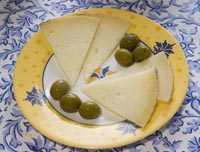

There is only one Manchego cheese. While there are many different types of cheeses produced in Spain, Manchego is the most well-known and widely-available.
 Like all the ‘original’ tapas ingredients, this cheese has a long history and tradition.
Like all the ‘original’ tapas ingredients, this cheese has a long history and tradition.
It was even mentioned by Cervantes in his famous literary tale: Don Quixote of La Mancha.
There are two types of Manchego cheese: the artisanal (farmhouse) type which is made with unpasteurized milk, and the commercial type made with pasteurized milk. They are both available either semi-cured or cured.
Whichever type you may choose, the only genuine cheese is made from whole sheep’s milk from the Manchega sheep which are bred and reared in the region of Castillo La Mancha.
This is a huge region, just south of Madrid, which is known for its high plateau landscape and extremes of temperature.
You can buy it by the wedge or as a whole cheese. Whole cheeses are, on average, about 20cm (8”) in diameter and 8-10cm (3-4”) deep. A whole cheese will weigh about 3kg (7lb).
They have a distinctive zig-zag pattern on the outer rind which is produced from moulds of esparto grass and wooden presses.
The rind encloses the whole cheese and ranges in colour from yellow to a brown-ish beige. The inside is usually firm, but can range from med to hard, and has a few small air pockets spread throughout. The colour is cream to pale yellow.
There are, however, many other Spanish sheep's milk cheeses with similar shape and rind markings, commonly known as ‘Manchego style’ cheese.
Flavour-wise, some of these are indeed on a par with the genuine article, and are generally cheaper, but they are not a true Manchego. It’s worth experimenting though.
The taste is very distinctive, slightly salty but not too strong. It is creamy with a slight piquancy, and with the characteristic aftertaste of sheep’s milk.
Just like wine, Serrano ham and olive oil, Manchego cheese is protected by its Denominación de Origén. This controls its production, ensures the exclusive use of milk only from the Manchega sheep, and dictates an ageing period of a minimum of two months.
The best way to serve it is to cut a wedge out of the cheese, take the bottom bit of rind off, then cut it into slices about 6mm (1/4”) thick. Nothing fancy, that's it.
A nice glass of fino or manzanilla sherry, a few olives and you’re in business.
What could be easier - or more tasty?!